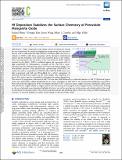| dc.contributor.author | Bliem, Roland | |
| dc.contributor.author | Kim, Dongha | |
| dc.contributor.author | Wang, Jiayue | |
| dc.contributor.author | Crumlin, Ethan J | |
| dc.contributor.author | Yildiz, Bilge | |
| dc.date.accessioned | 2021-10-27T19:52:04Z | |
| dc.date.available | 2021-10-27T19:52:04Z | |
| dc.date.issued | 2021 | |
| dc.identifier.uri | https://hdl.handle.net/1721.1/133315 | |
| dc.description.abstract | Stable composition and catalytic activity of surfaces are among the key requirements for materials employed in energy storage and conversion devices, such as solid oxide fuel cells (SOFCs). Perovskite oxides that serve as cathode in SOFCs suffer from segregation of the aliovalent substitutional cations and the formation of an inert, non-conductive phase at the surface. Here, we demonstrate that the surface of the state-of-the-art SOFC cathode material La0.8Sr0.2MnO3 (LSM) is stabilized against the segregation of Sr at high temperature by submonolayer coverages of Hf. The Hf is vapor-deposited onto the LSM thin film surface by e-beam evaporation. Using in situ near-ambient pressure X-ray photoelectron spectroscopy (NAP-XPS), we analyze the surface composition of LSM thin films. Half the LSM surface was kept as-prepared, and half was Hf-modified, for a direct comparison of untreated and Hf-treated regions on the same sample. The formation of a binary SrOx surface species is quantified as descriptor for surface degradation. The onset of Sr segregation is observed at 450 °C on the bare LSM, followed by a substantial advance at 550 °C. Hf-treated regions of the same LSM surface exhibit significantly less Sr surface segregation at 450-550 °C. We interpret this stabilization imparted by Hf to arise from the suppression of the electrostatic attraction of Sr2+ cations to surface oxygen vacancies. Doping the surface layer with Hf, that has a higher affinity to oxygen, reduces this attraction by decreasing the surface oxygen vacancy concentration. In doing so, the use of physical vapor deposition highlights the direct role of the metal species in this system and excludes artifacts that could be introduced via chemical routes. The present work demonstrates this stabilizing effect of Hf on the surface of LSM, broadening the relevance of our prior findings on surface metal doping of other perovskite oxides. | |
| dc.language.iso | en | |
| dc.publisher | American Chemical Society (ACS) | |
| dc.relation.isversionof | 10.1021/acs.jpcc.0c09707 | |
| dc.rights | Creative Commons Attribution 4.0 International license | |
| dc.rights.uri | https://creativecommons.org/licenses/by/4.0/ | |
| dc.source | ACS | |
| dc.title | Hf Deposition Stabilizes the Surface Chemistry of Perovskite Manganite Oxide | |
| dc.type | Article | |
| dc.contributor.department | Massachusetts Institute of Technology. Department of Materials Science and Engineering | |
| dc.contributor.department | Massachusetts Institute of Technology. Department of Nuclear Science and Engineering | |
| dc.relation.journal | Journal of Physical Chemistry C | |
| dc.eprint.version | Final published version | |
| dc.type.uri | http://purl.org/eprint/type/JournalArticle | |
| eprint.status | http://purl.org/eprint/status/PeerReviewed | |
| dc.date.updated | 2021-08-11T13:26:56Z | |
| dspace.orderedauthors | Bliem, R; Kim, D; Wang, J; Crumlin, EJ; Yildiz, B | |
| dspace.date.submission | 2021-08-11T13:26:58Z | |
| mit.journal.volume | 125 | |
| mit.journal.issue | 6 | |
| mit.license | PUBLISHER_CC | |
| mit.metadata.status | Authority Work and Publication Information Needed | |
